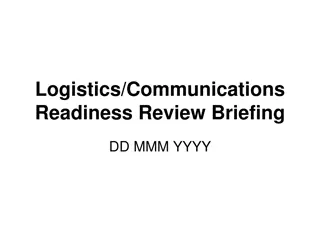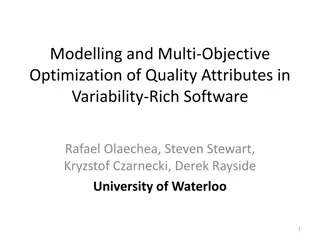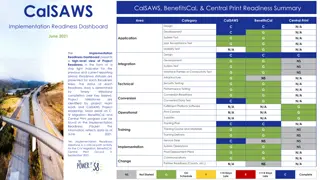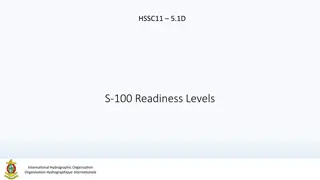Modeling Scientific Software Architecture for Feature Readiness
This work discusses the importance of understanding software architecture in assessing the readiness of user-facing features in scientific software. It explores the challenges of testing complex features, presents a motivating example, and emphasizes the role of subject matter experts in validating feature quality. The study highlights the need for architectural insights to gather evidence on feature readiness effectively.
- Software architecture
- Scientific software
- Feature readiness
- Testing challenges
- Subject matter experts
Download Presentation

Please find below an Image/Link to download the presentation.
The content on the website is provided AS IS for your information and personal use only. It may not be sold, licensed, or shared on other websites without obtaining consent from the author. Download presentation by click this link. If you encounter any issues during the download, it is possible that the publisher has removed the file from their server.
E N D
Presentation Transcript
Exceptional service in the national interest Modeling Scientific Software Architecture from Regression Tests using Data Mining Techniques Is feature X ready for my intended use? Matthew Mosby With Jake Healy, Tony Nguyen and Chris Siefert ASC Sustainable Scientific Software Conference NLIT Summit, Milwaukee, WI June 27-30, 2023 This work was supported by the Laboratory Directed Research and Development program at Sandia National Laboratories, a multimission laboratory managed and operated by National Technology and Engineering Solutions of Sandia LLC, a wholly owned subsidiary of Honeywell International Inc. for the U.S. Department of Energy s National Nuclear Security Administration under contract DE-NA0003525. Sandia National Laboratories is a multimission laboratory managed and operated by National Technology and Engineering Solutions of Sandia LLC, a wholly owned subsidiary of Honeywell International Inc. for the U.S. Department of Energy s National Nuclear Security Administration under contract DE-NA0003525. SAND2023-05296C
IS FEATURE X READY FOR MY INTENDED USE? As a user of SciSoft, how can I be confident that a given feature is ready for use? What evidence is available to me for deciding between two similar features? Feature (n): user input to a scientific software program that activates a specific capability or behavior Examples: Material model formulation Active physics (e.g., contact) Solver selection Time integration scheme Discretization Typical Evidence: Overall software test coverage Identify that the feature is tested SME assertion that the feature is ready Is this evidence sufficient? 2
A (VERY) SIMPLE MOTIVATING EXAMPLE Feature: Elastic/Linearly plastic material Credibility Evidence: The overall code coverage is 90% The model is used in several tests o The code SME isn t available Quiz time: How many conditions are in this model? Could those branches be in the 10% missing code coverage? What can a user assert about the quality of tests this model was used in? Nothing, this is why the SME is involved! Nothing, this is why the SME is involved! 5 5 What would change if the user were presented with the following? Absolutely Absolutely Estimated coverage of <feature>: 30% Goal: Enable such feedback 3
WHAT DOES ANY OF THAT HAVE TO DO WITH SOFTWARE ARCHITECTURE? ... SciSoft is complex, long-lived & changing SciSoft is often written by scientists and not computerscientists Features are often difficult to test in isolation Architecture (n): the relationship between a user-facing feature and its software implementation Understanding the architectureis a prerequisite to gathering feature-level readiness evidence ... Library-level dependency graph of the SIERRA/SM application 4
THE GENERAL APPROACH MINE THE REGRESSION TESTS General form: min? ? ?,? ? SciSoft typically have test suites Instrument the code/tests to provide: Features used by an execution Code coverage from an execution Conceptual linear form: Coverage Features Coverage Run the instrumented test suite Per-test records form training data Apply ML algorithms to construct a model of the architecture = Features Tests Tests C A B ML multi-label classifier ML multi-label classifier Given a feature (set), estimate the coverage set 5
WHAT CONSTITUTES A FEATURE? HOW TO IDENTIFY THEM? What Up to interpretation by user and/or SME General, e.g., model formulation Specific, e.g., sub-option/setting How Feature annotation by SME or automatic Automatic annotation strongly preferred Always up to date Supports user-annotation of input Extension to library-level SciSoft APIs Feature identification requirements Feature keys generated by unique context Keys don t encode parameter/option values Keys can be mapped back to input command Key (e.g.) Input begin material steel 0d4f3dd density = 0.000756 b16b186 begin parameters for model ml_ep_fail 698c7e7 youngs modulus = {youngs} 3a1dac5 poissons ratio = {poissons} <...> yield stress = {yield} <...> ... <...> end <none> end <none> 6
FORMING THE TRAINING DATA (A, C) Constructing C Optional level of detail: File, Function, Edge, Line Greater detail increases dimension Conceptual linear form: Coverage Features Coverage = Features C A B Tests Tests Run tests with coverage instrumentation Label columns of C with coverage keys Each test provides a (sparse) row of C Constructing A Run tests logging what features are used Label columns of A with feature keys Each test results in a (sparse) row of A 7
MODELING THE ARCHITECTURE (B) Conceptual linear form: Coverage Features Coverage Features = C A B Tests Tests Architecture modeling can be framed as a ML multi-label classification problem We are using available classifiers Decision Tree classifiers are good for our type of data Use series of splits based on parameter influence Suffer from variance and bias can be reduced by ensembles Titanic passenger survival model as a decision tree classifier [1] [1] Lovinger, J., Valova, I. Infinite Lattice Learner: an ensemble for incremental learning. Soft Comput 24 24, 6957 6974 (2020). 8
ASIDE: SOFTWARE SUSTAINABILITY & CREDIBILITY BENEFITS FROM ABILITY TO AUTOMATICALLY GATHER THE TRAINING DATA Conceptual linear form: Coverage Features Coverage = Features C A B Tests Tests Benefits from C Supports optimal test-suite construction Faster CI for large projects Targeted change-based testing Benefits from A Feature coverage database Statistics on how apps used in the wild Identification of weak/untested features Automatically gathering this data is foundational to a variety of potential user- & developer-facing credibility and productivity tools 9
THE DATASET: SIERRA/SM (SOLID MECHANICS) APP SIERRA Engineering Mechanics Code Suite SIERRA Engineering Mechanics Code Suite Source Lines of Code (C/C++) # Regression and unit tests % Source line coverage ~2M ~20k ~75% Focus on Solid Mechanics app Focusing on the small tests in the suite Use Feature Coverage Tool for building A Use LLVM CoverageSanitizer for B Custom callback for file-level coverage SIERRA/SM Dataset details SIERRA/SM Dataset details # Tests (samples) # Features # Covered Files (labels) 6393 7005 5347 Conceptual linear form: Coverage Features Coverage Features = C A B Tests Tests 10
INITIAL RESULTS Features (7005) Coverage (5347) Examine performance of two classifiers Split test with all data to train/test and 30% reserved for training Use native score fraction of 100% correct sample predictions Samples (6393) 1.4% non-zeros Sparsity pattern of training data. Note high coverage density. 29% 29% non-zeros Classifier Classifier Test % Test % 0% 30% 0% 30% Train Score Train Score 0.64 0.68 0.64 0.68 Test Score Test Score - 0.24 - 0.24 ExtraTrees1 Features Coverage 6k RandomForest2 High feature diversity in samples mainline coverage impacts over-fit Count Can filtering the training data improve fit/predictions? 0 0 6k Sample Occurrence [1] https://scikit-learn.org/stable/modules/generated/sklearn.ensemble.ExtraTreesClassifier.html [2] https://scikit-learn.org/stable/modules/generated/sklearn.ensemble.RandomForestClassifier.html 11
FILTERING THE TRAINING DATASET Sparsity pattern of reduced training data. Coverage (4284) Features (6992) Desire automatic approaches Identify duplicate samples Reduce duplicate samples with union of coverage data 1-core vs. N-core cases of the same test Samples (3468) 0.8% non-zeros 12% non-zeros Remove mainline features and coverage Filter out columns with >= 99% fill Removed features: boilerplate, e.g., begin sierra Removed coverage: libraries (e.g., ioss, stk), parsing 7k Features Coverage Maintain high feature diversity in samples Count Greatly reduced mainline coverage 0 0 3.5k Sample Occurrence 12
FILTERING THE TRAINING DATASET SIERRA/SM Reduced Dataset Details SIERRA/SM Reduced Dataset Details # Tests (samples) # Features # Covered Files (labels) 3468 6992 4284 Classifier performance on reduced dataset Classifier Classifier Test % Test % Train Score Train Score 0% 30% 0% 30% Test Score Test Score - 0.183 - 0.169 Full Sample Score Full Sample Score 0.622 - 0.621 - 1.0 1.0 0.999 0.998 ExtraTrees1 RandomForest2 Reduced training dataset provides better fit and maintains accuracy for the full sample set [1] https://scikit-learn.org/stable/modules/generated/sklearn.ensemble.ExtraTreesClassifier.html [2] https://scikit-learn.org/stable/modules/generated/sklearn.ensemble.RandomForestClassifier.html 13
EXPERIMENT: IDENTIFICATION OF FEATURE SUPPORT SIERRA/SM has typical structure of a 30 year old SciSoft package Materials do have a well-defined interface All models implemented in Lam library Source file names relate to model name Able to construct/verify known label set bin/adagio liblame.a Given a feature key for a material model, If the model is accurate, Then the model will predict Lam library files that support that model Bonus: If the model is precise, the prediction doesn t contain other sources /MLEP.C /Elastic.h /johnson_cook_model.F 15
RESULTS: IDENTIFICATION OF FEATURE SUPPORT Material: elastic # Samples # Correct Lam labels # Wrong Lam labels # Non-Lam labels Material: johnson_cook # Samples # Correct Lam labels # Wrong Lam labels # Non-Lam labels 2305 7 of 7 0 259 61 5 of 9 2 291 Material: dsa Material: mlep # Samples # Correct Lam labels # Wrong Lam labels # Non-Lam labels 28 5 of 7 2 245 # Samples # Correct Lam labels # Wrong Lam labels # Non-Lam labels 68 5 of 10 2 245 # Samples is the number of times the specified material appears in the training data Too much noise/bias in the model Predicts everything is elastic 16
USE SME GUIDANCE TO FOCUS TRAINING DATASET FOR MATERIALS Know that all material models are implemented in lame/ directory Know feature correlation, i.e., model options are associated with the specific model Reduce feature set to possible materials Reduce coverage set to files in lame/ Train sub-model with reduced dataset SIERRA/SM Material Only Dataset SIERRA/SM Material Only Dataset # Tests (samples) # Features (materials) # Covered Files (labels) 3468 135 681 Model Model elastic mlep *johnson_cook *dsa jc + mlep * Model never used alone in sample set # Correct # Correct 7 of 7 10 of 10 9 of 9 7 of 7 8 of 14 How might we automatically detect these reduced spaces to improve accuracy? 17
SUMMARY All Features Model Can predict which source files cover a given input deck with ~60% accuracy Current model is noisy Identifies a lot of library-type files Overpredicts coverage for specific features Bias from sample feature distribution Can improve new developer productivity Provide pointers to where a feature is implemented, even if not super specific Poor predictor of specific features without sub-modeling Segmented models can improve accuracy elastic mlep elastic dsa Materials Only Model elastic elastic mlep mlep dsa dsa 18
FUTURE WORK Open Questions Can we using unsupervised learning to automatically discover correlated features and construct piecewise models spanning the feature space? How could we sustainably incorporated SME knowledge? Is overprediction of file coverage acceptable? To what extent? Can we train to this metric? Next Steps to Provide User Feedback Query full coverage data given files supporting a feature Develop coverage metric meaningful to an end user Integrate information into other user-facing credibility tools 19
ACKNOWLEDGEMENTS Jake Healy Tony Nguyen Chris Siefert CIS Project 229302 Sandia National Laboratories is a multi-mission laboratory managed and operated by National Technology & Engineering Solutions of Sandia, LLC (NTESS), a wholly owned subsidiary of Honeywell International Inc., for the U.S. Department of Energy s National Nuclear Security Administration (DOE/NNSA) under contract DE- NA0003525. This written work is authored by an employee of NTESS. The employee, not NTESS, owns the right, title and interest in and to the written work and is responsible for its contents. Any subjective views or opinions that might be expressed in the written work do not necessarily represent the views of the U.S. Government. The publisher acknowledges that the U.S. Government retains a non-exclusive, paid-up, irrevocable, world-wide license to publish or reproduce the published form of this written work or allow others to do so, for U.S. Government purposes. The DOE will provide public access to results of federally sponsored research in accordance with the DOE Public Access Plan. 20























